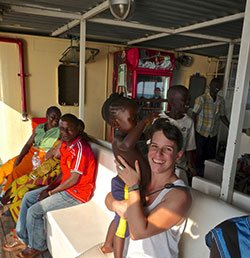When I saw the ship docked in Kigoma on the western-most edge of Tanzania along the shores of Lake Tanganyika, I wasn’t that impressed. With cracking paint, weathered timber planks, and a thoroughly scratched hull, it looked more dingy than distinguished.
But riding the M.V. Liemba through Lake Tanganyika’s cool, crystalline waters, the longest lake in the world, changed my perspective in a way that only looking at this vessel surely could not have. Over the course of a 32-hour journey, I was able to see beyond the boat’s built-up grime and soot, and to appreciate how its years of service —100 since the Germans built it as a warship in 1913 — have made it a beacon in this isolated part of the world. After all, the Liemba is more than a ship really. It is a lifeline.
The first time I saw the Liemba was two years earlier during a reporting trip in the Democratic Republic of the Congo, which, along with Tanzania, Burundi and Zambia, borders the lake. The ship was docked in the small port town of Moba having recently returned refugees who fled eastern Congo’s many years of violence. It was a rare foray into the Congo. The ship’s main route hews closely to the Tanzanian coast.
Hearing stories from my source on that trip about her adventures on the historic Liemba piqued my interest. What would it be like, I wondered, to see this uncommon place from the deck of a ship that had been sailing these waters for 100 years? How could a curious adventurer not be drawn to this remarkable corner of the world? My chance to find out came last fall. I knew Lake Tanganyika was stunning. Imposing mountains, humming with near constant bird song, border the waters. Along the edges of secluded beaches, graceful volcanic rock formations rise from the depths. Quiet, deeply impoverished, villages where homes are made of mud and thatched grass, dot the coastline. Sunset and sunrise are hours of peaceful glory.
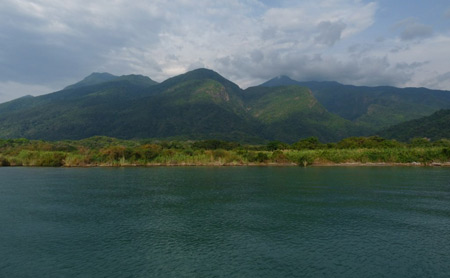
The more I learned about Lake Tanganyika, however, I was struck by how few people had ever heard of it or had any idea where it is. Here is the longest lake in the world, holding a full 17 percent of the entire planet’s fresh water, with about 10 million people living in the basin. It’s surrounded by nations whose resource wealth and political instability should be of major global concern. Yet rarely can anyone even properly pronounce its name.The upside to such isolation is that I still had the chance to see a part of Africa mostly untouched by modern hands — before the resorts pop up and the alumni tours drop in. Like seeing Bali before the surfers, or Goa, India, before the parties. I wanted that singular opportunity.
Located in Africa’s Great Rift Valley, Lake Tanganyika was formed about 10 to 12 million years ago. It is about 420 miles long, and 45 miles at its widest point. Not only the world’s longest lake, it is also the second deepest — only Lake Baikal in Siberia is deeper.
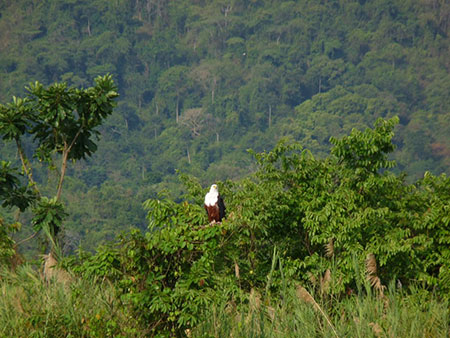
The draws for a traveler are many: Approximately 250 species of cichlid fish swim in these waters, several found nowhere else. A dizzying array of wildlife including chimpanzees, hippos, crocodiles, warthogs and a bevy of melodic birds live in the jungles and miombo forests on shore. Jane Goodall did her pioneering chimpanzee research here in Gombe Stream National Park, a few hours by local boat from Kigoma. The study is ongoing. Getting to the lake requires several days of travel and it’s not cheap. Parts of the coastline are among the most inaccessible places I have ever been. Many villages have no electricity, cell phone service, running water, or roads. These villages, where time moves so slowly that it just about stands still, are the back of the beyond, the ultra remote. And it’s why the Liemba is so important.

Every other Wednesday the ship leaves Kigoma and sails about 350 miles south to Mpulungu, Zambia, arriving on Friday. After 17 stops along the way, the Liemba returns north, traveling the same route, reaching Kigoma on Sunday. Each way, the ship can, and usually does, carry up to 600 passengers and 200 tons of cargo. The day of my departure was hot and dry. The rains had yet to start and the sun baked. The area in front of the dock was buzzing. Vendors with small, impermanent stalls sold sodas, bottled water, bread, fruit and other goods. Passengers milled about. Some sat in groups on the ground, their belongings and suitcases stacked around and under them. Babies cried. Others sucked on their mother’s exposed breasts. Some sat under a shaded waiting area patiently doing nothing.
Cargo was piled everywhere: sacks of maize flour, wheat flour, and sugar; bundles wrapped in white plastic, bulging boxes held together with rope, crates of glass bottles, heaps of bright green plantains, plastic jugs and buckets, cigarettes, and sandals. Porters, dressed in tattered red shirts emblazoned with the letters “TPA,” for Tanzania Ports Authority, trudged back and forth, hunched under the weight of it all. Somewhere music played.

It took me a minute to find the booking office, and some muscle to hold my place in line there. Eventually I paid for my VIP cabin. Louise Horsefall, owner with her husband Chris Horsefall, of the Lake Shore Lodge reserved the spot for me. Their elegant, scenic lodge, located in the tiny village of Kipili in the southern portion of Tanzania’s shoreline, was my destination. Horsefall advised I take the special room because it has a private bathroom. To me, that’s worth the extra bills.
Ticket in hand, I boarded and climbed two steep flights to the top deck where the VIP cabins sit not far from the ship’s noisy, blackened, smoke stacks. I threw my things in my room and checked that the ceiling fan worked. To my great relief it did.
Outside, I watched other passengers load. Women toted babies tied to their backs by colorful fabrics while simultaneously balancing luggage on their heads and carrying more in each hand. Children scurried behind their parents. Those with lower-class tickets, crammed into the stuffy space in the ship’s belly filled with rows of wooden tables and benches. Round windows on the walls provided a little air.
At about 5:30 pm the ship’s foghorn billowed. We left Kigoma and headed south. Soon the sky was turning shades of pink and I bought a beer.
Before the Liemba became this bi-monthly ferry, the ship had a more hawkish purpose. In 1913, German shipyard owner Joseph Meyer received an order to build a ship that would ultimately be almost 1100 tons, nearly 230 feet long and 33 feet wide. Forged of steel in Papenburg, Germany, the behemoth vessel was originally called the Graf von Götzen. With Lake Tanganyika abutting colonial German East Africa, comprised of what are now Burundi, Rwanda and Tanzania, the ship was to be an integral part of Germany’s effort to control the lake during World War I. Germany’s wartime enemies, the Belgians and the British, claimed the Belgian Congo and Northern Rhodesia, just across the lake and to the south, now the Democratic Republic of the Congo and Zambia, respectively. The Götzen was transported in five thousand crates, on four freighters, and over hundreds of miles of rail and by foot to Lake Tanganyika. It was rebuilt in Kigoma and launched in June 1915 with a steam engine and guns installed.
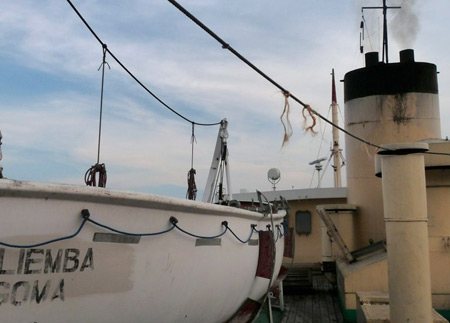
As the war progressed the Germans lost ground. They didn’t want the Götzen to fall into enemy hands so in July 1916 they scuttled the ship at the mouth of the Malagarasi river, south of Kigoma. Sailors greased the engines to protect them should the boat ever be sailed again.
The British raised the ship in 1924, found its engines marvelously preserved, restored the boat to service, and set the newly named M.V. Liemba to sail again in May 1927. The boat has been plying Lake Tanganyika’s waters ever since. Titus Benjamin, the 46-year-old Liemba captain with a childlike face, and a few wisps of grey hair that reveal his age, said these days, foreigners show up for every journey.
“Each trip there are not less than six,” said Benjamin, who has been guiding the storied vessel for 15 years. “We get many tourists.”
I counted about a dozen on my trip. Even if that many sailed on every journey, it would amount to less than 600 a year, paling in comparison to some of Tanzania’s major tourist draws: Mt. Kilimanjaro, for example, gets between 25,000 and 40,000 climbers annually. I took Benjamin’s “many” lightly. Riding the Liemba remains a rare journey.Among my fellow travelers were some American students studying abroad, and traveling to the lakeside Mahale Mountains National Park to see chimpanzees in the wild, a trip I too would later make. They heard the Liemba was soon to be taken out of commission entirely, making our voyage rarer still. Not so, said Giliard Abel, managing director of the Kigoma branch of the Marine Services Company, which owns the Liemba.
He said his company is, however, talking with the German government about making improvements including new timber planks for the decks and more efficient engines. Abel said they have also requested maintenance funds from the Tanzanian government but those had yet to come through when we spoke.
“They don’t see the importance of these vessels,” he said of Tanzanian officials, “because they fly over.”
But I did see the ship’s importance, and very soon after we shipped out of Kigoma. The Liemba’s centrality to the survival of the many isolated lakeside communities here becomes clear with the frenzy at each stop. Along the route, there are only three physical docks, although four others are currently being built. Thus when the Liemba stops it pulls up across from lakeside villages but not on shore. What happens next is only mildly controlled pandemonium.
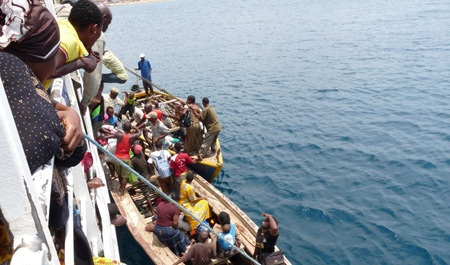
The routine at each stop was largely the same. The ship’s foghorn rang out twice as it slowed and wooden canoes from shore hurried to meet it. Young men steered the boats as passengers clutched their children and their luggage, their necks craned upwards. During the day nearly everyone on board — Africans and tourists alike — left their seats and their conversations to lean over the railings and stare in awe at the commotion. Even during a middle-of-the-night stop while awake from a bathroom break I was not alone watching the chaotic scene.
The shouting started immediately as the local boats came into view. When they got close enough their crews threw ropes to Liemba passengers who tied them to the ship’s railings. Then the scramble began.
After the first boat took its place next to the Liemba, subsequent boats pulled up next to it, extending down the side of the ship and out into the lake. Together they made a rocking bridge over which anyone wanting to get on or off of the Liemba would have to climb. I didn’t like the looks of this unstable system. I started to fear my own departure many hours later.
Baggage was thrown haphazardly and passengers swayed with the rolling waters as they moved from one boat to the next. Adults hurriedly took babies and small children by a single arm, dangling them precariously over the water, and passed them from the big boat to the smaller ones, or vice versa. Some children remained surprisingly calm. Others wailed. I watched with baited breath until they finally landed safely in their mother’s arms.
Simultaneously, and with the shouting unabated, lithe young men shot themselves up the tall sides of the Liemba like real-life Spidermen. When they reached the railings they swung their legs over swiftly and disappeared into the crowds. This Liemba hustle was fast, acrobatic.
Watching this scene replayed at every isolated stop, I realized that the scramble underscored what Captain Benjamin told me about the ship’s importance to the lakeside populations: “It goes to areas with no roads,” he said simply. “They depend on this ship.”
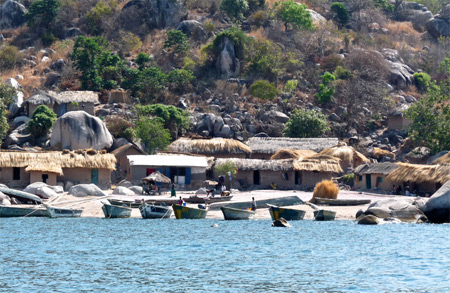
For many the vessel is the only way to trade and travel. In bad weather, which is not uncommon, the lake can be as dangerous as the open the ocean. The Liemba is really the only passenger vessel that can safely maneuver the tempestuous winds and waves at their worst. There are local water taxis and small canoes, but if a storm strikes, these can be deadly.
In a medical emergency the Liemba becomes a vital link for areas where health clinics are little more than mud huts. It can ferry the sick to the few regional hospitals where more advanced care is available. On board, Captain Benjamin and his six officers can be of some help. All are trained in first aid. They have even delivered babies. “Yeah, sure,” Captain Benjamin said nonchalantly of bringing humans into the world. He estimated that he has about 10 deliveries per year.
The Liemba is thus equal parts floating relic, tourist attraction, essential transport, and ambulance. For the most impoverished, missing the ship could spell catastrophe. This, I saw, is where the frenzy comes from. This is what dependence can look like.
Without the distraction and excitement of the stops, the hours moved slowly. I wiled away my time reading, chatting with other travelers, admiring the views and playing with the children on board. One little girl, whose name, Penda, is the Swahili word for love, was asleep when I first noticed her. When she woke I smiled and waved.
“Jambo,” I said, trying to draw her in. “Habari?” I used all of my Swahili to say hello and how are you? She didn’t answer. A few repetitions and some peek-a-boo later, and she inched closer.
Eventually she was in my lap and I was tossing her gently in the air as she giggled. “Tena! Tena!” She squealed with delight, asking me to throw her again and again. I did until my arms gave out.
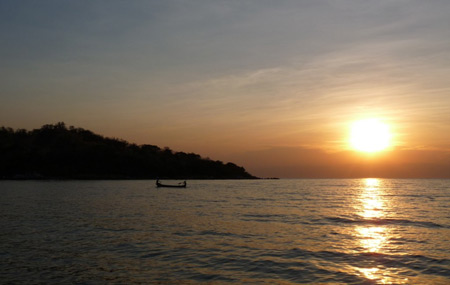
At night I saw warm lights bobbing along the distant horizon. I later learned these were fishing boats on the hunt for dagaa, the local sardine. To catch the tiny, silvery treasures, two big boats string a net between them and smaller boats with lanterns move in concentric circles around them. The glow draws the fish into the nets. The scene was romantic, almost mythic.
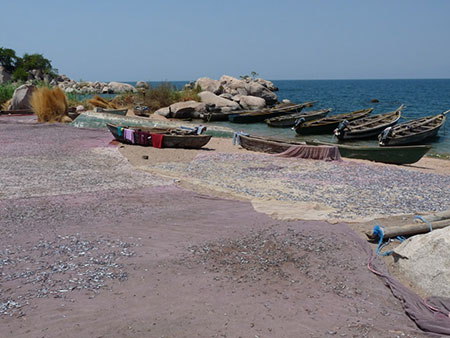
It was nearly two in the morning when we reached Kipili, my departure point. I lugged my bags into the bowels of the ship passing passengers sleeping on every deck and in the hallways. A rooster, strapped to a box, sat silently.I watched the local boats emerge from utter blackness into the bright halo cast from the Liemba’s spotlight. The shouting began and soon I saw Louise’s husband, Chris Horsefall, pulling up in his small boat. With the assistance of others, including an unsuspecting man whose shoulder was helpfully nearby, I made it safely over two local canoes and into Chris’s boat without coming close to falling in. Fears allayed.
When we pulled away from the Liemba, I was sad to see it go. Ablaze in light, the mighty ship looked glorious and far from dingy. Watching it fade from view, I then saw the Liemba as a true beacon, 100 years and counting. • 1 March 2013
